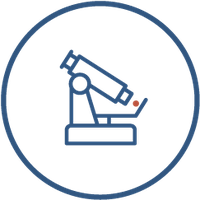Published: 17 January 2023
BioAscent’s growing reputation for computational chemistry expertise has led to a continued increase in demand from customers across the globe. Dr Christopher Faulkner joined the team in June 2022 to support this growth. In this blog he shares his career journey, from the experiences which first sparked his interest in computational chemistry, through to joining BioAscent.
Christopher studied Chemistry at the University of Strathclyde, where he did a five-year MChem degree with a placement year. It was during his placement year that Christopher had his first exposure into computational chemistry, working on a hybrid project with both the synthetic chemistry group and the computational chemistry group. That experience inspired Christopher to focus his final year project in computational chemistry, looking at the use of molecular dynamics simulations to predict the partition coefficients of small molecules, with his thesis winning the JLS Alan Memorial Prize.
Thanks to a keen interest in using computational chemistry techniques to study biological systems, Christopher decided to go to Cardiff University to complete his PhD, a four-year CASE studentship working with an external industrial collaborator: the Atomic Weapons Establishment.
The project involved studying the interactions of general anesthetics and opioids with biological membranes and ion channel proteins and led to four peer reviewed publications. Christopher recalls:
“This was my first experience of working with an industrial partner. It gave me the opportunity to present my research through an external organisation and write about complicated computational chemistry techniques for a non-expert audience. I really enjoyed this experience and was able to do this at several conferences and seminars throughout my PhD.”
Upon completion of his PhD, Christopher secured the position of Computational Chemist in the In Silico Discovery Team at BioAscent and joined the company in June 2022.
Commenting on BioAscent, Christopher says:
“The great thing about working at BioAscent is the huge variety in the types of projects I get to work on, across all different drug target classes – ion channel proteins, kinases etc. as well as different therapeutic areas such as oncology and CNS.”
“BioAscent offers a highly collaborative environment, and it is hugely advantageous to be able to work with internal medicinal chemists and the biologists on projects. This gives a lot of exposure to different points of views about projects and solving problems. Being able to combine different viewpoints, expertise, and ideas, from both the internal BioAscent groups, as well as with our customers, helps us to work out the best solutions to problems, maximizing the likelihood of success for our customers.”
Working with the wider in silico discovery team helps with discussing ideas and sharing results in real time. The team uses modelling packages for docking ligands / drug-like molecules into target proteins to understand the specific interactions of that ligand with the protein, assisting the drug design process. Gromacs is also used for molecular dynamics simulations to model receptor-ligand interactions over time in more realistic physiological conditions.
Demand for BioAscent’s Computational Chemistry expertise has continued to grow, and the in silico team is working on multiple projects across all stages of the drug design process, some of which are collaborative, integrated drug discovery projects, others specifically focused on computational chemistry.
To find out more about career opportunities and working at BioAscent, click here.




